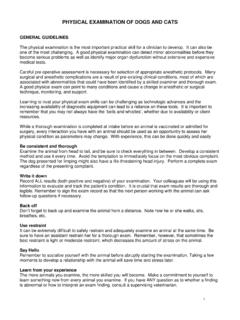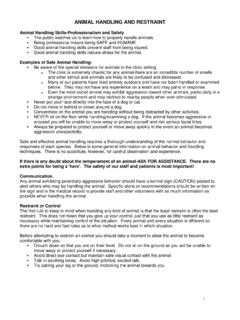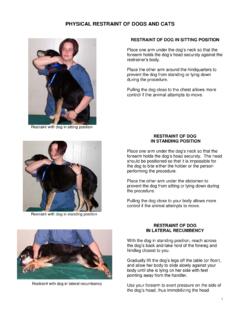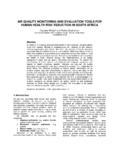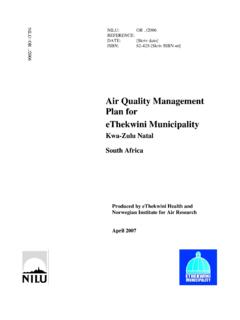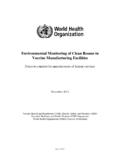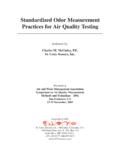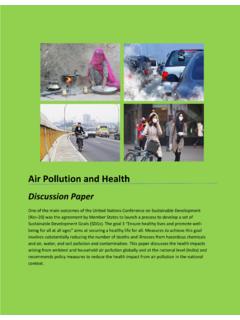Transcription of MONITORING THE ANESTHETIZED PATIENT - …
1 1 MONITORING THE ANESTHETIZED PATIENT The administration and MONITORING of anesthesia for surgical procedures is a complex and multifaceted skill that requires both knowledge and practice. The safety of your PATIENT is dependent on your awareness and response to potential problems. A thorough understanding of the principles of anesthetic MONITORING and awareness of normal and abnormal PATIENT parameters is crucial to providing safe anesthesia. The most important thing to remember is to ASK QUESTIONS-anytime you have a question or concern about a PATIENT 's status. Don t ever hesitate to ask for help. It is the anesthetist's sole responsibility to monitor the safety of his/her PATIENT at all times.
2 An ANESTHETIZED animal should NEVER be left unattended for any reason. MONITORING of the ANESTHETIZED PATIENT is a continual process throughout the anesthetic event from pre-medication to full recovery. Vital signs and other MONITORING parameters are recorded to the surgery record every 5 minutes throughout the procedure, but PATIENT MONITORING should be continuous. The anesthetist should be aware of subtle changes in parameters and prepared to address any issues immediately as they arise. Remember when assessing the ANESTHETIZED PATIENT that, while absolute numbers are obviously important, subtle change and trends are often an early indicator that the PATIENT is beginning to decompensate.
3 Do not wait until a PATIENT 's MONITORING parameters are in the critical range to act or to ask for assistance. These training materials are intended as a basic review of these important topics. For more information please refer to one of the numerous texts available. As you review these materials, keep in mind that anesthesia and surgery are clinical skills, not just academic pursuits. You are going to be DOING these things, not just passing an exam. If you have questions about any of this information you are welcome to contact us prior to your trip. PARAMETERS TO BE ASSESSED CONTINOUSLY THROUGHOUT ANESTHETIC PERIOD (RECORDED EVERY 5 MINUTES): Respiratory Airway Respiratory rate, depth and character Oxygen saturation (SpO2) Cardiovascular Heart rate and rhythm Pulse rate and strength Mucous membrane color and capillary refill time Arterial blood pressure Body Temperature Anesthetic depth/ PATIENT status Reflexes and muscle tone Eye position and pupillary reflex activity Heart and respiratory rates Status of surgical procedure Equipment function Anesthetic level, Vaporizer and oxygen flowmeter settings Pressure relief (pop-off) valve 2 ASSESSING MONITORING PARAMETERS Respiratory Airway Check regularly that the endotracheal tube has not kinked, slipped out or been placed too deeply.
4 Listen for accumulation of moisture in the endotracheal tube. In recovery, animals should be placed with the neck extended so the ET tube is not bent or kinked. Recovering animals should be placed facing forward in their cages with the tongue protruding to allow easy visualization of the animal's mucous membrane color. Respiratory rate (RR), depth and character Normal RR: 10-20 breaths/minute (rates up to 40 may be seen occasionally) Normal inspiration lasts seconds and expiration lasts 2-3 seconds Basic respiratory MONITORING is based on clinical observations. The rate and depth can be assessed by observing movement of the chest or reservoir bag. Chest excursions should be assessed with both spontaneous respiration and assisted ventilation.
5 Respiratory rate and character can be evaluated via esophageal stethoscope. The degree of compliance felt when manually ventilating the animal can provide important information about potential respiratory or mechanical dysfunction. With increasing depth of anesthesia there is a decrease in both the rate and tidal volume (volume of air taken in with each breath). When the animal hypoventilates, some alveoli may not adequately inflate. These alveoli partially collapse, leading to atelectasis. Periodic 'bagging' (every 5 minutes) throughout the procedure can prevent this. To bag a PATIENT , partially close pop-off valve and gently squeeze the reservoir bag just enough to cause a slight rise in the chest.
6 Be sure to re-open the pop-off valve to avoid the buildup of pressure in the anesthetic circuit. An abnormally low respiratory rate (<8-10 bpm) is cause for concern and should be reported to a supervising veterinarian or technician immediately. Apneic animals who are otherwise maintained at an appropriate anesthetic level may need to be manually ventilated throughout the procedure at a rate of 8-12 bpm. The anesthetist may occasionally note an increase in respiratory rate (tachypnea) and depth (hyperventilation). True hyperventilation and tachypnea (as opposed to panting) are the body's response to increased carbon dioxide in the blood or metabolic acidosis. Hyperventilation may indicate that the CO2 is not being adequately removed from the breathing circuit by the CO2 absorber.
7 Hyperventilation is also seen as a response to mild surgical stimulus ( when surgeon pulls on suspensory ligament during OVH). An elevated respiratory rate may indicate a progression from moderate to light anesthesia and is often one of the first signs of arousal from anesthesia. Breathing should be smooth and regular, with thoracic and diaphragmatic components. Difficult or labored breathing may indicate the presence of an airway obstruction. Animals ANESTHETIZED with ketamine may exhibit an apneustic respiratory pattern, in which inspiration is followed by a prolonged pause before expiration. Normal respiratory sounds are almost inaudible. Harsh noises, whistles or squeaks may indicate narrow or obstructed airways or the presence of fluid in the airways.
8 Oxygen saturation (SpO2) - (see ' MONITORING Equipment' for more information) Normal SpO2 : 95-100% The PATIENT 's SpO2 is the percentage of oxygen-saturated hemoglobin, and indicates how well the lungs are delivering oxygen to the blood. The pulse oximeter measures both SpO2 and heart rate and is monitored continuously. 3 A pulse ox reading of 90-95% indicates that the PATIENT 's hemoglobin is not fully saturated and a respiratory or cardiovascular problem may be present. The PATIENT will not become hypoxic until the reading falls to 90% or less. It is hoped that the anesthetist will be able to correct the problem before this occurs. Without pulse oximetry, early hypoxia can be difficult to assess as cyanosis only becomes apparent if values fall below 85% saturation.
9 As with any MONITORING device, the pulse oximeter can sometimes fail or provide an inaccurate reading. Anytime the reading changes significantly, evaluate the clinical status of your PATIENT before assuming that the reading is accurate. However, do not assume that a low reading is a malfunction. Again, EVALUATE YOUR PATIENT before making any decisions. Cardiovascular Heart rate (HR) and rhythm Normal HR: Canine: 80-120 bpm; Feline: 100-180 bpm Assess via auscultation. Bradycardia may indicate excessive anesthetic depth, a response to vagal stimulation or other causes. Heart rates less than 80 bpm in dogs and 100 bpm in cats should be reported to a supervising veterinarian or technician for evaluation.
10 Tachycardia may be a response to surgical stimulation and, in combination with other factors may indicate an inadequate anesthetic level. However, some response to surgical stimulation is normal. The presence of a beating heart does not necessarily mean that circulation is adequate. Heartbeat should always be assessed in conjunction with pulse strength and quality. Pulse rate and strength/quality The pulse can be detected at several locations, including the lingual, femoral, carotid and dorsal pedal arteries. You should know a least 3 different places to evaluate a pulse. The pulse should be strong and synchronized with the heartbeat. Mucous membrane (MM) color and capillary refill time (CRT) Normal: mm pink, CRT < 2 sec Mucous membrane color is usually most easily assessed at the gingiva.
